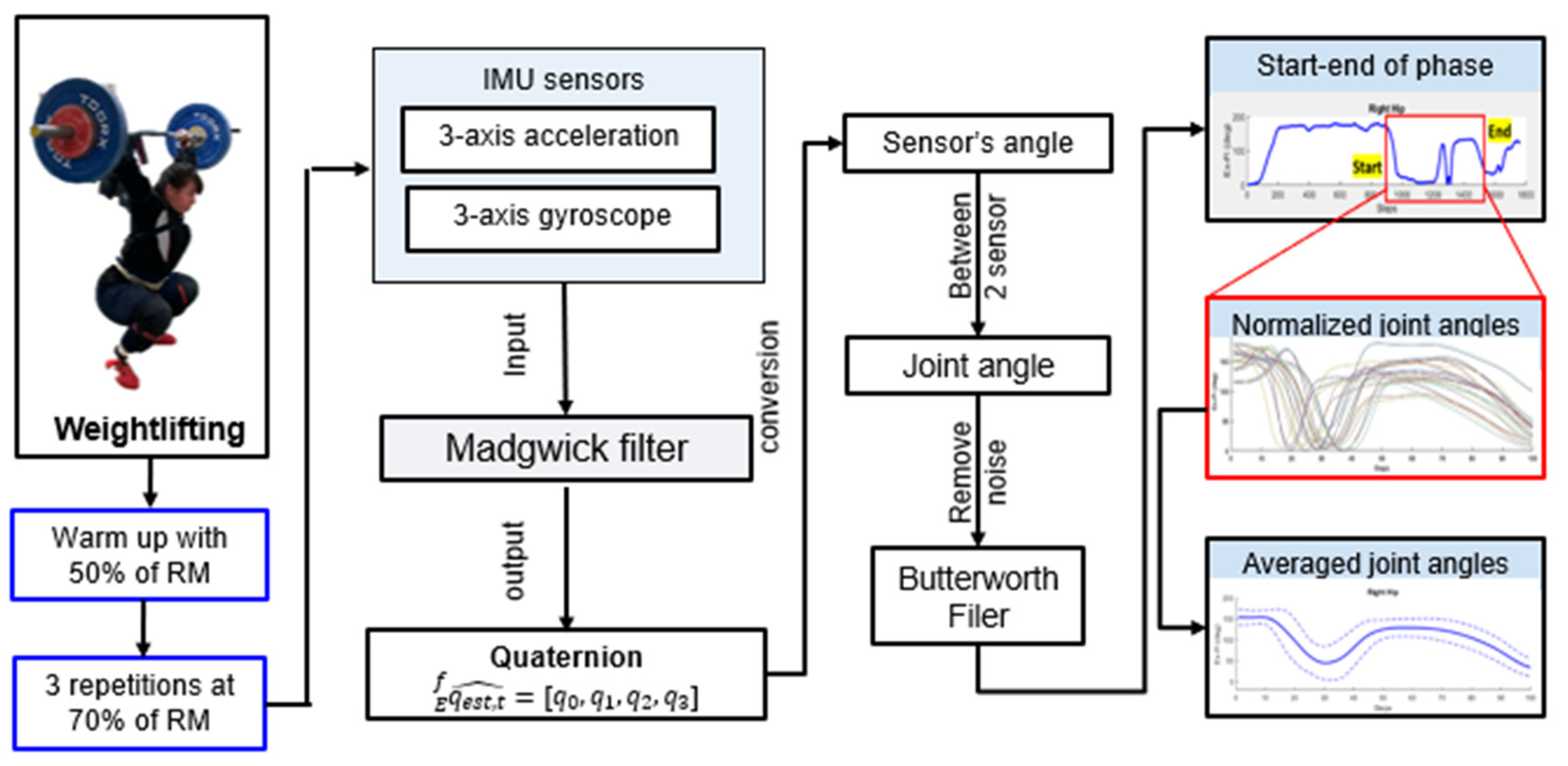Kinematic Characteristics of National and College Level Weightlifters during the Snatch Technique Using Wearable Inertial Sensors †
Abstract
:1. Introduction
2. Materials and Methods
3. Results
4. Discussion and Conclusions
Author Contributions
Funding
Institutional Review Board Statement
Informed Consent Statement
Acknowledgments
Conflicts of Interest
References
- Gourgoulis, V.; Aggeloussis, N.; Antoniou, P.; Christoforidis, C.; Mavromatis, G.; Garas, A. Comparative 3-dimensional kinematic analysis of the snatch technique in elite male and female greek weightlifters. J. Strength Cond. Res. 2002, 16, 359–366. [Google Scholar] [CrossRef] [PubMed]
- Ho, L.K.W.; Lorenzen, C.; Wilson, C.J.; Saunders, J.E.; Williams, M.D. Reviewing Current Knowledge in Snatch Performance and Technique. J. Strength Cond. Res. 2014, 28, 574–586. [Google Scholar] [CrossRef]
- Campos, J.; Poletaev, P.; Cuesta, A.; Pablos, C.; Carratalá, V. Kinematical analysis of the snatch in elite male junior weightlifters of different weight categories. J. Strength Cond. Res. 2006, 20, 843–850. [Google Scholar] [CrossRef] [PubMed]
- Harbili, E.; Alptekin, A. Comparative kinematic analysis of the snatch lifts in elite male adolescent weightlifters. J. Sport. Sci. Med. 2014, 13, 417–422. [Google Scholar]
- AkkuŞ, H. Kinematic Analysis of the Snatch Lift with Elite Female Weightlifters During the 2010 World Weightlifting Championship. J. Strength Cond. Res. 2012, 26, 897–905. [Google Scholar] [CrossRef] [PubMed] [Green Version]
- Madgwick, S. An Efficient Orientation Filter for Inertial and Inertial/Magnetic Sensor Arrays; University of Bristol: Bristol, UK, 2010. [Google Scholar]
- Choi, Y.C.; Khuyagbaatar, B.; Cheon, M.; Batbayar, T.; Lee, S.; Kim, Y.H. Kinematic Comparison of Double Poling Techniques Between National and College Level Cross-Country Skiers Using Wearable Inertial Measurement Unit Sensors. Int. J. Precis. Eng. Manuf. 2021, 22, 1105–1112. [Google Scholar] [CrossRef]
- Purevsuren, T.; Khuyagbaatar, B.; Kim, K.; Kim, Y.H. Investigation of knee joint forces and moments during short-track speed skating using wearable motion analysis system. Int. J. Precis. Eng. Manuf. 2018, 19, 1055–1060. [Google Scholar] [CrossRef]



| Subjects | Weight Category (kg) | Age (Year) | Height (cm) | Body Weight (kg) | |
|---|---|---|---|---|---|
| National-level (NL) | 1 | 55 | 21 | 150 | 52 |
| 2 | 76 | 22 | 162 | 82 | |
| 3 | 87 | 21 | 163 | 87 | |
| College-level (CL) | 4 | 71 | 18 | 151 | 72 |
| 5 | 55 | 18 | 152 | 55 | |
| 6 | 71 | 17 | 155 | 70 | |
| 7 | 64 | 18 | 158 | 64 | |
Publisher’s Note: MDPI stays neutral with regard to jurisdictional claims in published maps and institutional affiliations. |
© 2021 by the authors. Licensee MDPI, Basel, Switzerland. This article is an open access article distributed under the terms and conditions of the Creative Commons Attribution (CC BY) license (https://creativecommons.org/licenses/by/4.0/).
Share and Cite
Tumurbaatar, M.; Khuyagbaatar, B.; Kim, Y.H.; Danaa, G. Kinematic Characteristics of National and College Level Weightlifters during the Snatch Technique Using Wearable Inertial Sensors. Eng. Proc. 2021, 10, 22. https://doi.org/10.3390/ecsa-8-11255
Tumurbaatar M, Khuyagbaatar B, Kim YH, Danaa G. Kinematic Characteristics of National and College Level Weightlifters during the Snatch Technique Using Wearable Inertial Sensors. Engineering Proceedings. 2021; 10(1):22. https://doi.org/10.3390/ecsa-8-11255
Chicago/Turabian StyleTumurbaatar, Munkhbat, Batbayar Khuyagbaatar, Yoon Hyuk Kim, and Ganbat Danaa. 2021. "Kinematic Characteristics of National and College Level Weightlifters during the Snatch Technique Using Wearable Inertial Sensors" Engineering Proceedings 10, no. 1: 22. https://doi.org/10.3390/ecsa-8-11255
APA StyleTumurbaatar, M., Khuyagbaatar, B., Kim, Y. H., & Danaa, G. (2021). Kinematic Characteristics of National and College Level Weightlifters during the Snatch Technique Using Wearable Inertial Sensors. Engineering Proceedings, 10(1), 22. https://doi.org/10.3390/ecsa-8-11255







